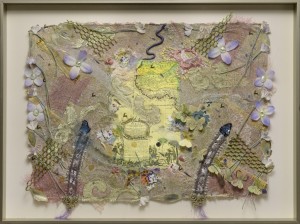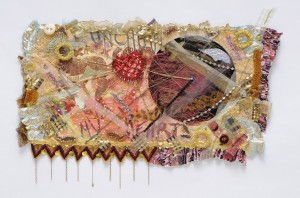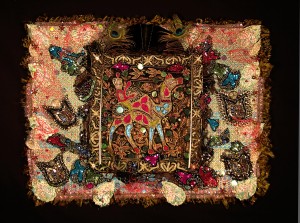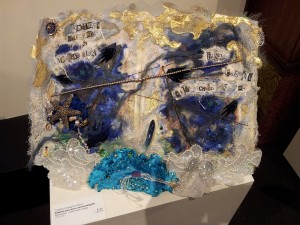

At the outset of her poetic presentation, Carletta Carrington Wilson declared that her exhibition “Unchain My Heart” (listen!) is a testament to mystery. Her exhibition at Art Xchange Gallery included selections from three series of works, “constellation of shadows and leaves” (2006) “Orange You Mingus” (2008-9), and “book of the bound” (2011-12). The artist explained that as she prepared her exhibition she realized they formed a triptych that was unified by the theme of chains, chains as shackles, as ornament, as connections.

Carletta Carrington Wilson kiss of air, tongue of fire, 2006,fabric, beads, paper, found objects, © Carletta Carrington Wilson photo by Ken Wagner
“constellation of shadows and leaves” begins the theme of chains (here one appears to mark the coast of Africa) as well as the articulation of the role of cloth in the slave trade. The works here are referred to as maps by the artist; these maps invoke the sites of slavery through fabric, beads, found objects and chains, most of all though fabrics.
“kiss of air, tongue of fire”: the strange jolt of the title suggests the contradictions of eighteenth century life. The map appears in the center, as an early cartouche of Africa, inscribed in Latin with the trading of humans as a decorative surrounding. Around the cartouche, and easily overlooked, are several tiny figures cut out from a cotton shirt making reference to the labor of the cotton fields.
The rococo era to which these decorative colors belong is France in the 18th century, as well as the height of the American colonies connection to France. Think of those movies with the elegantly attired women dancing formal patterns with equally elegantly attired men as their partners. All of that elegance was born in the slave trade, in the shipping of humans, in the harvesting of cotton, in the milling of fabric. Wilson has researched the slave trade deeply, and she has here created a subtle map of it, evoking the act of slaves through fabrics created by slaves as well as embedding references to it in snakes that penetrate the scene. Here is Carletta Carrington Wilson speaking about these works:
constellation of shadows and leaves
“My fingers move across silk, wool, gabardine, mohair, brocade, chiffon, crepe, seersucker, cotton. Sometimes the cloth is solid an occasional stripe, but mostly, and foremost floral.
“I chart cloth’s language, its artifice, mimicry and mischief mirroring the worlds we discover and rediscover in skin.”**
Wilson emphasized that the slave trade was not over, in fact it is much larger and more invisible than it was in the period of the African slave trade.

Carletta Carrington Wilson, Unchain My Heart, 2009, Fabric beads, costume jewelry, found objects, © Carletta Carrington Wilson photo by Ken Wagner
In 2009 Wilson held an exhibition called “Orange You Mingus”, making reference in the titles of the works to the music of the 1950s. “Orange was the Color of Her Dress,” is the title of a Charles Mingus piece. “Unchain My Heart” is of course, a Ray Charles Song. In this stunning collage “Unchain My Heart”, and the title work of the exhibition, we see a vinyl record embedded in the piece, and a red heart from which chains extend in many materials layered one on top of another, making it difficult to penetrate the surface both literally and metaphorically. There are also layers of transparent fabrics suggesting the swing and rhythm of music, veils, fifties and sixties fashion and much more. Here is what Carletta Carrington Wilson wrote about this exhibition:
“At heart is a linking of love and loss. Vein, thread, vector of the connector, a chain lies between the two like a noisy road.” In each link’s metallic moment, a papery passageway, a threaded trail stitched upon lips in chains of thought, lingua franca of this forged union. What love-lost ties the trying line together? Is mid-point of oppositional forces? What lock unlocks the language that created the key to the mystery of what holds the holder and the held tethered, kept, yes, claimed.
“It was not meant to be, was not meant to come to this unwieldy conclusion. Like unlikely love, like ill-matched mating, enslavement binds bodies, slaver to slave, in an unholy matrimony of ring upon ring upon ring. Wedded to want, betrothed to the unyielding length’s grasp, the wedding march accompanied by an interminable din of clinks and clanks. Let us thank the rank music that was born of these unions, unions that are yet to be reconciled to their fate. Let must be music the key to set free, body and mind, from our unharmonious history. Unleash we from the bond of bondage in which they were taught to be the buying and th bought for is not this the woe we’ve wed. Oh, set we free … please… set/we/free.”**
This particular work addresses the fact of miscegenation, the entrapment of slaves by their masters, the wedding of the two bodies, then the music as a means to freedom. As the artist poetically read this introduction, I, as a white person, suddenly truly felt for the first time, my own connection to slavery, we were all intertwined.

Carletta Carrington Wilson, Night in Tunisia, 2008, Fabric, beads, costume jewelry, paper found objects, photo by Al Doggett ©Carletta Carrington Wilson
Another musical quotation is “Night in Tunisia.” A lush collage, it suggests elegant, mysterious nights as in the Ella Fitzgerald song (do listen while you look!). But a camel at the center, framed with several borders, evokes, the Arab slave trade, crossing the desert, the northern route in the Ottoman empire. The artist’s poetic words bring us to the music itself “Sound spins round, dizzy as a bird. Holler, moan, croon-cry rising in every moon-wide-eye. Jazz be this, razz, dzz a woo-dop-di-wop be bop . . .” **and much more.
So the evocation of music in the art work and the poetry is a reference, for Wilson, to the life of African American slaves as well as proud African Americans and music as a means of freedom.
The third section of the exhibition includes some examples from “book of the bound” a 2012 exhibition that I have written about previously on this blog. In the current exhibition, it is represented by examples such as“the old chain,” and “between innocence and morning fire”.

Carletta Carrington Wilson, between innocence and morning fire, 2011, altered book-mixed media collage, fabric beads, costume jewerly found objects, paint, oil pastel © Carletta Carrington Wilson, photo by Susan Platt
Both are created from books, covered with layers of ornate fabrics and chains of various sizes. In the first, we see elephants, who are, the artist emphasized, victimized still like the slaves in present day trade; in the second, we see the blue of the sea and the pearls of the ocean. “book of the bound” honored the silent slaves who never were able to tell their stories. The title of the exhibition refers to those who were bound; Wilson’s books are given as a gift to them. she found this quote for that exhibition, which makes an astonishing simile:
…for the slaves lie in two rows, one above the other, on each side of the ship, like books upon a shelf….
John Newton (18th Century sea captain. Slaver and composer of the song “Amazing Grace.”)
“The narrative of an individual captured into slavery, however, is cut out, torn off, written over and, summarily, silenced.”**
To present Carletta Carrington Wilson’s work is always daunting for me as a writer, since she is one of the most eloquent people in her own voice that I know. Her poetry, her narratives, her deep commitment to presenting slavery from so many different perspectives, all come together to create a compelling exhibition and performance. Her own voice speaking poetically is a partner to the visual art and cannot be separated from them.
And she also includes the voices of others. In an impromptu paper chain she encourages us to write our own messages to the distant slaves. The moving result, the poetic messages, hang from a corner, and spill into our hearts with their heartfelt emotions “ To the Distant Relatives who faced the Door of No Return, I have tried to represent you and will continue to thank you for surviving the best way I can.” That is only one of the many links in this chain.
**Note: All quotations from poetry © Carletta Carrington Wilson are used by permission of Carletta Carrington Wilson